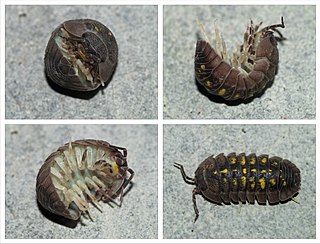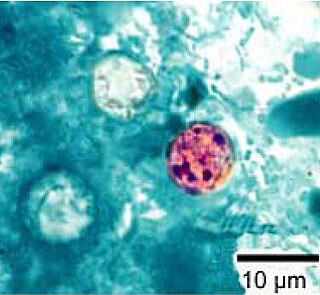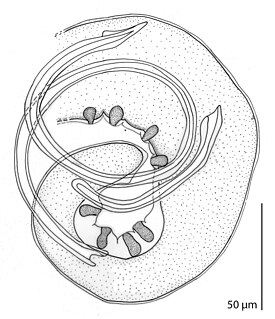
Anisakis is a genus of parasitic nematodes that have life cycles involving fish and marine mammals. They are infective to humans and cause anisakiasis. People who produce immunoglobulin E in response to this parasite may subsequently have an allergic reaction, including anaphylaxis, after eating fish infected with Anisakis species.

Armadillidiidae is a family of woodlice, a terrestrial crustacean group in the order Isopoda. Unlike members of other woodlice families, members of this family can roll into a ball, an ability they share with the outwardly similar but unrelated pill millipedes and other animals. This ability gives woodlice in this family their common names of pill bugs or roly polies. Other common names include slaters,potato bugs, doodle bugs and cheeselogs. Most species are native to the Mediterranean Basin, while a few species have wider European distributions. The best known species, Armadillidium vulgare was introduced to New England in the early 19th century, and has become widespread throughout North America.
Acanthocheilonema is a genus within the family Onchocercidae which comprises mainly tropical parasitic worms. Cobbold created the genus Acanthocheilonema with only one species, Acanthocheilonema dracunculoides, which was collected from aardwolf in the region of South Africa in the nineteenth century. These parasites have a wide range of mammalian species as hosts, including members of Carnivora, Macroscelidea, Rodentia, Pholidota, Edentata, and Marsupialia. Many species among several genera of filarioids exhibit a high degree of endemicity in studies done on mammalian species in Japan. However, no concrete evidence has confirmed any endemic species in the genus Acanthocheilonema.
Elaeophora is a genus of parasitic nematodes which live attached to the interior surfaces of major arteries, veins and/or heart chambers in various large mammal hosts. Infestation with Elaeophora species is referred to as elaeophorosis. The species of Elaeophora have been found in Africa, Asia, Europe, and North America. Despite the fact that they produce aneurysms in the arteries and heart of their hosts which measure up to 2 cm in diameter, overt clinical symptoms of infestation are seldom reported, with the notable exception of E. schneideri infestation in sheep, elk, and moose.

Pill millipedes are any members of two living orders of millipedes, often grouped together into a single superorder, Oniscomorpha. The name Oniscomorpha refers to the millipedes' resemblance to certain woodlice (Oniscidea), also called pillbugs or "roly-polies". However, millipedes and woodlice are not closely related ; rather, this is a case of convergent evolution.

Cicindela, commonly known as common tiger beetles are generally brightly colored and metallic beetles, often with some sort of patterning of ivory or cream-colored markings. They are most abundant and diverse in habitats very often near bodies of water with sandy or occasionally clay soils; they can be found along rivers, sea and lake shores, sand dunes, around dry lakebeds, on clay banks, or woodland paths.

Glomerida is an order of pill-millipedes found primarily in the Northern Hemisphere. They superficially resemble pill-bugs or woodlice, and can enroll into a protective ball. They have twelve body segments, 17 to 19 pairs of legs, and males have enlarged rear legs involved in mating. The order includes about 30 genera and at least 280 species, including Glomeris marginata, the common European pill-millipede. The order contains members in Europe, South-east Asia and the Americas from California to Guatemala. Although historically considered closely related with the similar sphaerotheriidans that also enroll, some DNA evidence suggest they may be more closely related to glomeridesmidans, a poorly known order that does not enroll.
Aphelenchoides is a genus of mycetophagous nematodes. Some species are plant pathogenic foliar nematodes.

Glomeris is largely European genus of pill millipedes. It contains over 100 species, distributed across Europe, but also extending into the Canary Islands, Turkey, and eleven species from North Africa.

Cephalotes atratus is a species of arboreal ant in the genus Cephalotes, a genus characterized by its odd shaped head. These ants are known as gliding ants because of their ability to "parachute" by steering their fall if they lose their footing.

Hassalstrongylus is a genus of nematode worms that infect mostly muroid rodents from eastern North America to South America. The genus is part of the Heligmonellidae and related to genera like Stilestrongylus.

Sphaerotheriida is an order of millipedes in the infraclass Pentazonia, sometimes known as giant pill millipedes. They inhabit Southern Africa, Madagascar, South and Southeast Asia, Australia and New Zealand. Like the Northern Hemisphere pill millipedes of the order Glomerida, these millipedes can roll into a ball when disturbed. When they are rolled-up, most sphaerotheriidans reach a maximum size of a cherry or golf ball, but some species from Madagascar can even reach the size of an orange. When rolled-up, predators are unable to unravel giant pill millipedes since the margins of their second and last dorsal plates fit perfectly into one another, creating a sealed ball. A few giant pill millipede species are able to produce sound, the only millipedes known to do this. This order of millipedes is also unique in that some African species are used for medicinal purposes.

Cyclospora is a genus of apicomplexan parasites. It includes the species Cyclospora cayetanensis, the causative agent of cyclosporiasis. Members of Cyclospora are characterized as having oocysts with two sporocysts, each containing two sporozoites.

Louis-Joseph Alcide Railliet was a French veterinarian and helminthologist.

Glomeris klugii is a species of pill millipedes.
Lipotropha is a genus of parasitic alveolates of the phylum Apicomplexa.
Traklosia is a genus of nematodes. The genus was originally circumscribed in 1961 under the name Robertia; L. Travassos and G. R. Kloss created this genus for their newly-described species R. leiperi. The nomen novum, Traklosia, was created for this genus in 2015 — Robertia was an invalid name due to a senior homonym. It consists of three species found in Brazil and Cuba, and they are parasites of millipedes.

Cystidicolidae is a family of spirurian nematodes. It was created by Skrjabin in 1946. All members of the family are parasites of fish.

Volvation, is a defensive behavior in certain animals, in which the animal rolls its own body into a ball, presenting only the hardest parts of its integument, or its spines to predators.













